UBC THEATRE & FILM PRESENTS EDWARD IION THE SUBJECT

THE DEPARTMENT OF THEATRE & FILM AT UBC PRESENTSEDWARD II BY CHRISTOPHER MARLOWE
Directed by Guest Artist Mary Vingoe
EDWARD II, A MONARCH DESTROYED BY DESIRE
UBC Theatre and Film launches its 2016-‘17 season with Edward II by Christopher Marlowe at The Chan Centre for the Performing Art’s Telus Studio Theatre.
Directed by guest artist Mary Vingoe, Edward II is one of the earliest Elizabethan history plays. A story of politics, passion, and murder, the play leads to a fractured England and a monarchy in violent disarray. Newly crowned, drunk on power and blind to consequences, King Edward II recalls his lover Gaveston from exile and showers him with kingly favours, alienating both queen and court.
Back at the Telus Studio Theatre after a two-year hiatus, Edward II is performed using the 12 towers on three levels arranged in a horseshoe shape of the Telus to offer a total sensory and surround sound theatrical experience. The play is made magical by set design advisor Robert Gardiner’s mirrored set, lighting designer Sophie Tang’s clever lighting and costume designer Kiara Lawson’s 1930s-inspired costumes.
Led by Mary Vingoe, nationally renowned director, artistic director, teacher, actor and playwright, Edward II features the BFA Acting and BFA/MFA Design and Production students showcasing their considerable talents as they complete their final year.
September 29-October 15, 2016. 7:30 pm
The Chan Centre for Performing Arts
Telus Studio Theatre
6265 Crescent Rd.
University of British Columbia, Vancouver, CANADA
Wayfinding: http://www.maps.ubc.ca
Performances:
Wednesday-Saturday
Preview: September 28
Opening Night Reception: September 29
Alumni Night + Post-Show Talkback-October 5
Tickets:
$11.50 - $24.50
Box office: 604.822.2678, box.office@ubc.ca or www.ubctheatretickets.com

Professor and Head, Department of Theatre and FilmStephen Heatley
Welcome from the Department Head
Part of my summer reading plan this year was tucking into Theatre of the Unimpressed, the provocative book by Canadian theatre wunderkind, Jordan Tannahill. In it, Tannahill challenges us emphatically as theatre makers to focus on the live-ness of the theatre event, the aspects of it which cannot be replicated in recorded forms, the aspects of the theatre that encourage us to be in some kind of real relationship with each other in real time.
In this spirit, I am so pleased to welcome you to our 2016/17 Theatre season here at UBC which promises to be a celebration of “live-ness” beginning with our return, after a 2 ½ year hiatus, to our most theatrical of performance venues, the Telus Studio Theatre. The studio demands that we consider the theatre experience three dimensionally with the audience a palpable player in the drama. By definition, the actors and the audience are entirely present with each other in this space. The muscular and poetic language of the play also underlines its live-ness. The play was written at a time when “live” was the only choice.
We are very fortunate and grateful to have acquired the talents of Mary Vingoe, one of Canada’s finest theatre directors and pioneers to guide us through the intricate theatrical landscape of the exciting and rarely seen Edward II, written by a theatrical wunderkind of his own time, Christopher Marlowe. This production, as always, features the work of our acting, design and production students.
Next up in November, back in the Frederic Wood Theatre, is an alumni presentation of some of the works of Samuel Beckett led by the inimitable Gerald Vanderwoude entitled Beckett 16. In January and March, we feature the work of our two MFA directors, Lauren Taylor - Love and Information by Caryl Churchill, and Diane Brown - Les Belles-Soeurs by Michel Tremblay.
There are lots of other opportunities to share in the work of our students this year; through Tom Scholte’s “Naked Cinema” project, the intimate productions staged in the Dorothy Somerset Studio Theatre on University Boulevard, and at the Persistence of Vision Festival (POV 27) at the end of the school year featuring the films made by our BFA filmmakers.
Thank you for joining us and we hope to see you in our environs often this season.
Cheers,
Stephen
Stephen Heatley
Head, Department of Theatre and Film
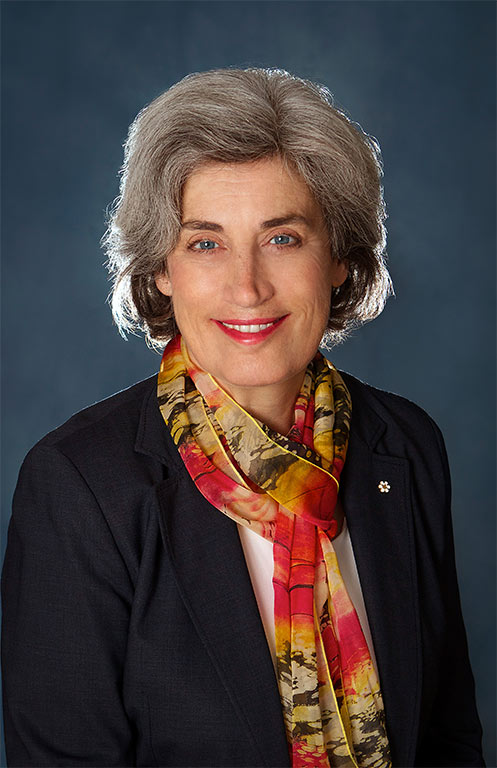
DIRECTOR AND GUEST ARTISTMARY VINGOE
Edward II tells the story of a man who loved not wisely but too well.
The play, the complete title of which is The troublesome raigne and lamentable death of Edward the second, King of England: with the tragicall fall of proud Mortimer is likely Marlowe's penultimate work, written a year before his death from injuries sustained in a bar room brawl in 1593.
Marlowe was a shoemaker's son who attended Cambridge on a scholarship with the goal of taking holy orders. Sons of commoners were admitted for the first time into universities as Queen Elizabeth's new Protestant England needed clergy.
Marlowe was a brilliant if erratic and troublesome student. He was conscripted into the secret service by Sir Robert Cecil to root out Catholic plots to overthrow Queen Elizabeth I. He regularly saw men betrayed, bankrupted and brutally tortured for their beliefs. As an avowed atheist, a homosexual, a playwright and a spy, Marlowe was always, it seems, in trouble with someone.
Edward II is a play about power and its corrupting effect. It is a dissertation on the deadly intersection of the personal sphere and the public one. Edward is an unfit King because he cannot separate the two. This was of much interest to Elizabethan audiences as Elizabeth was much admired for her ability to forswear personal life for the public good. In the opening few scenes, Edward breaks his father's command, promotes his lover far beyond his due, torments the bishop and insults his lawful queen. His blind passion for Galveston destroys him. But in the end it also ennobles him.
There are forty-two speaking parts in the original play. I have reduced that number to fifteen. In editing the play, I have attempted to focus on the love of Edward and Gaveston, Edward's personal trauma and the rivalry with Mortimer and Isabella and less on the historical detail of the French/English wars which would have been entertaining for an Elizabethan audience but can be mind bogglingly complicated for us.
I have set the period for our production in 1930s. This is not an historical recreation but rather a keynote period for our story which is told as a morality play in a non-specific time. The whiff of fascism hangs around the edges of our story and Edward has a counterpart in the weak English King Edward XIII who was forced to abdicate for forbidden love in 1936. Likewise, Mortimer takes on many Mussolini/Hitler type qualities of the fascist dictator.
I would like to extend my thanks to Professor David Overton of Dalhousie University and Professor Reina Green of Mount St Vincent University for their help with deciphering this tremendously challenging play and to my friend Alexis Milligan for providing me with the excellent ensemble exercises.
It has been a joy to work with the graduating acting class at UBC. Thank you to Professor Stephen Heatley and to the entire design and production team here for the opportunity to bring this challenging piece to the Telus stage.
Mary Vingoe, September, 2016.
Mary Vingoe
Director and Guest Artist
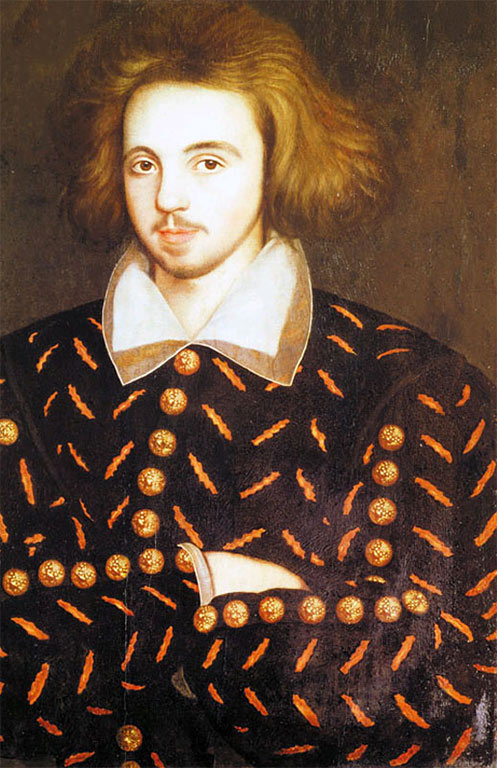
playwright christopher marlowe
(Photo credit: An anonymous portrait in Corpus Christi College, Cambridge)
Christopher Marlowe, also known as Kit Marlowe (baptised 26 February 1564 – 30 May 1593), was an English playwright, poet and translator of the Elizabethan era. Marlowe was the foremost Elizabethan tragedian of his day. He greatly influenced William Shakespeare, who was born in the same year as Marlowe and who rose to become the pre-eminent Elizabethan playwright after Marlowe's mysterious early death. Marlowe's plays are known for the use of blank verse and their overreaching protagonists.
A warrant was issued for Marlowe's arrest on 18 May 1593. No reason was given for it, though it was thought to be connected to allegations of blasphemy—a manuscript believed to have been written by Marlowe was said to contain "vile heretical conceipts". On 20 May he was brought to the court to attend upon the Privy Council for questioning. There is no record of their having met that day, however, and he was commanded to attend upon them each day thereafter until "licensed to the contrary". Ten days later, he was stabbed to death by Ingram Frizer. Whether the stabbing was connected to his arrest has never been resolved.
Edward II is a Renaissance or Early Modern period play written by Christopher Marlowe. It is one of the earliest English history plays. The full title of the first publication is The Troublesome Reign and Lamentable Death of Edward the Second, King of England, with the Tragical Fall of Proud Mortimer.
Marlowe found most of his material for this play in the third volume of Raphael Holinshed's Chronicles (1587). Frederick Boas believes that "out of all the rich material provided by Holinshed" Marlowe was drawn to "the comparatively unattractive reign of Edward II" due to the relationship between the King and Gaveston. Boas elaborates, "Homosexual affection ... has (as has been seen) a special attraction for Marlowe. Jove and Ganymede in Dido, Henry III and his 'minions' in The Massacre, Neptune and Leander in Hero and Leander, and all akin, although drawn to a slighter scale, to Edward and Gaveston." Boas also notes the existence of a number of parallels between Edward II and The Massacre at Paris, asserting that "it is scarcely too much to say that scenes xi–xxi of The Massacre are something in the nature of a preliminary sketch for Edward II." Marlowe stayed close to the account but embellished it with the character of Lightborn (or Lucifer) as Edward's assassin.
Excerpt from: Wikipedia
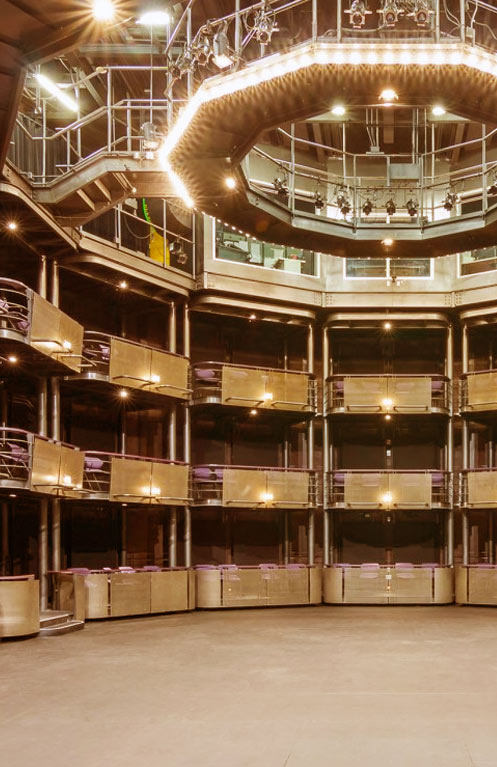
lighting designer & mfa candidate, UBC theatre & filmsophie tang
Q & A with Lighting Designer Sophie Tang, MFA candidate.
Q: What is your creative process like? In other words, how does a lighting designer create?
A: I go to run-throughs of the play as much as possible and get to know the play well. Thinking about where and when there could be lighting changes either to isolate the space, or create a mood, or indicate a location, is at the forefront as I watch.
Q: What are some of the challenges specific to the Telus Studio Theatre in the Chan Centre for the Performing Arts?
A: The space is very different from any of the spaces I have worked in. There are no grid or fly systems for hanging lights and the positions are different as well. Acting takes place inside the balconies as well as on stage so it is a 360 degree acting area. I need to take care of all the actors.
Q: What inspired you for Edward II?
A: Since this is a very traditional play with a minimal set, I would like to light it traditionally: no moving lights, no crazy colors; just pure theatre lighting with actors on stage.
Q: What do you like about lighting design?
A: I always feel like lighting is essential to a stage play and offers a kind of magic. Once lights hit on the actors, it really clarifies the story and gives a point of focus. Angle, color, and brightness of the lighting can create such a magical effect on stage. For example re: colour: we can use color as location, color as time, color as mood and so on. The possibilities are endless and I really enjoy that.
Q: What’s next for you?
A: I am doing a double thesis at UBC Design and Production. Edward II is my lighting thesis, and next term, I will be doing set design for Love and Information which will be my other thesis.
Q: What do you see yourself doing after you’ve graduated?
A: I would love to continue working as a professional lighting and set designer, and have been expanding into other related businesses like window displays, interior design, and event design. Bringing professional stage design elements into these fields has worked really well; clients enjoyed them immensely.
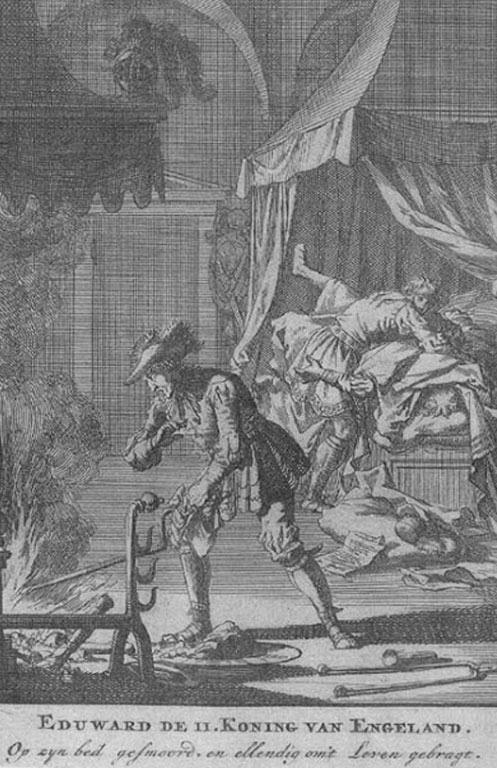
PhD candidate, Department of EnglishChris Gaudet
There’s a famous, horrible, and much-disputed moment towards the end of this play – no spoilers, since the title is, in part, “the troublesome raigne and lamentable death of […]” – where Edward II is killed. The stage direction in the edition I have in front of me is “[edward dies],” which makes a certain sense. But, as Marlowe scholars will tell you, that’s a decision made by a contemporary editor, since the first printings of the play gave no indication of how Edward’s death was to be staged.
I mention this in part because, assuming we’re all reading this while we wait for our companions to rejoin us and the play to begin, it will give us something distracting to think of when it comes to that (again: horrible, affecting, enraging) moment: oh that’s how they decided to do it! But also because the moment, however staged, is crucial to understanding the role of intimacy in the play, which is, from one perspective, to invite (paranoid) speculation and dismay.
The sexuality of the play’s spectators, throughout, is phobic. Couples provoke dismay in part because what goes on between them is (to borrow one of the play’s favourite words) obscure, and because that obscurity is an implicit threat to a political order built on display, on the public staging of stable hierarchal roles.
For Edward such obscurity is a positive vision. When he suggests, near the beginning of the play, that the rebellious nobles divide the kingdom up amongst themselves, and leave him “some nook or corner […] to frolic with my dearest Gaveston,” he’s proposing a dream of escape from the public gaze that the logic of drama makes impossible. His own paranoia and accusations about his wife might mark the same impulse to associate intimacy with secrecy and withdrawal.
Gaveston, who is Edward’s dearest Gaveston, and also (depending who you ask) a “sly, inveigling Frenchman,” is a figure of wild, wasteful, extravagant display, of a provoking and multiple openness thatdefies this logic of hidden motive. He is associated with “idle triumphs, masques, lascivious shows.” He “wears a short Italian hooded cloak, / Larded with pearl, and in his Tuscan cap / A jewel of more value than the crown” while he leans out the window of what Edward probably hoped would be a secluded hideaway to shout insults at the people walking by. He provokes envy (another of the play’s favourite words), and love, in proportion to his dramatic visibility, even, or especially, when he is, himself, offstage.
It is almost inevitable to conflate elements of the text with its author, a man whose life has always invited speculation, much of it in the paranoid style (he was a government spy; he was Shakespeare). Marlowe was in his late 20s when the play was first performed, and he was stabbed to death (through the eye, according to the coroner’s report) before its first printing in 1594. He was the kind of guy of whom it could plausibly be asserted during his lifetime that he had been overheard saying “that St John the Evangelist was bedfellow to Christ and leaned always in his bosom, that he used him as the sinners of Sodom,” and also the kind of guy of whom it could be said, following his death, that he “had in him those brave translunary things / That the first poets had.”
Chris Gaudet
PhD candidate, Department of English
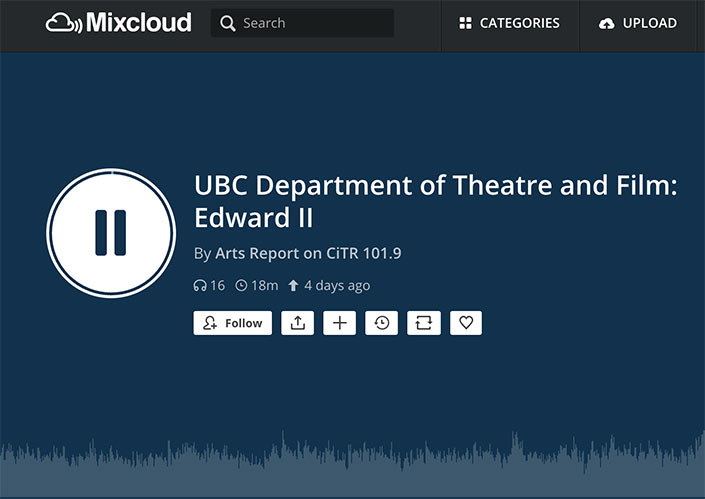
WITH ACTOR Daniel Curalli, SOUND DESIGNER EDWARD Dawson & COMPOSER TARYN PLATER.ARTS REPORT CiTR 101.9 INTERVIEW
CITR 101.9 Radio Station at UBC
Listen to interview on mixcloud
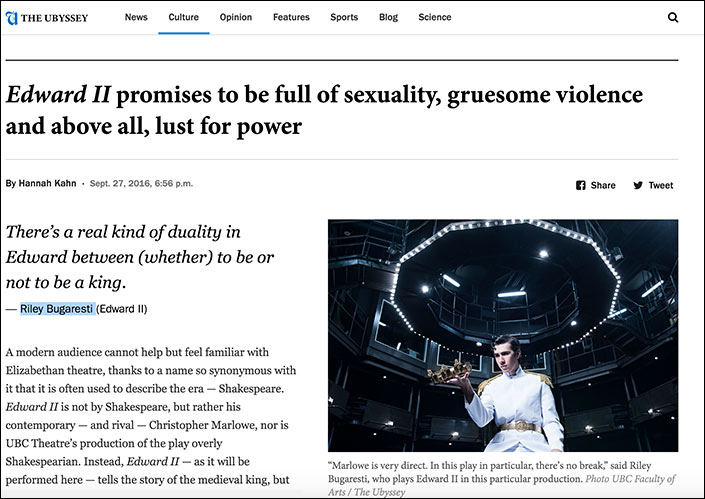
WITH ACTOR RILEY BUGARESTI by hannah kahn UBYSSEY INTERVIEW
Edward II promises to be full of sexuality, gruesome violence and above all, lust for power
By Hannah Kahn · Sept. 27, 2016, 6:56 p.m.
“Marlowe is very direct. In this play in particular, there’s no break,” said Riley Bugaresti, who plays Edward II in this particular production. Photo UBC Faculty of Arts / The Ubyssey There’s a real kind of duality in Edward between (whether) to be or not to be a king. — Riley Bugaresti (Edward II)
A modern audience cannot help but feel familiar with Elizabethan theatre, thanks to a name so synonymous with it that it is often used to describe the era — Shakespeare.Edward II is not by Shakespeare, but rather his contemporary — and rival — Christopher Marlowe, nor is UBC Theatre’s production of the play overly Shakespearian. Instead, Edward II — as it will be performed here — tells the story of the medieval king, but with modern themes and a setting in the early 20th century.
“Marlowe is very direct. In this play in particular, there’s no break,” said Riley Bugaresti, who plays Edward II in this particular production. “It’s full-speed the entire way. I think that, in a lot of ways, people who may have problems with the flowery language of Shakespeare aren’t going to have problems at this play [because] it's so action packed [and] Marlowe is very direct. You get what he’s saying — it’s kind of like an action Elizabethan in a way.”
Bugaresti, who is in his final year of the BFA acting program, may be familiar to the audiences of UBC’s A Face To The Wall/Fewer Emergencies, The Arabian Nights or The Dirty Dutch Rhino.
Edward II is one of the earliest Elizabethan histories, traditionally taking place in 1307. According to Bugaresti, “Edward II is the story of King Edward II and his love for his favourite in the court, Gaveston. It’s a play about a homosexual relationship — one of the first plays written about [one] — and Edward, he’s a man who loves not wisely, but too well.” Love, power, ambition — these themes, so well known to Game of Thrones fans and watchers of American politics alike, will be very familiar and as poignant as ever. As Bugaresti pointed out, “absolute power corrupts absolutely.” Political corruption is a timeless theme, relevant to almost any period in human history, as is the struggle for the LGBT community — a struggle poignantly tragic in Edward II — still being fought now.
It is an interesting concept to set a historical play in another time period, but Bugaresti explained that it's the themes of the play that let it transcend boundaries of time so well. Bugaresti pointed to another king who was forced to make sacrifices for love and another time that left a nation in chaos. “It’s loosely set in the 1930s just because there was the situation with Edward VIII where he abdicated with Wallis Simpson, which is a little similar, and it was also right before WWII,” said Bugaresti. “It’s interesting to think about Marlowe — this play was written in the early 1590s, it's about King Edward in 1307, it's set in our version of the 1930s and of course, the year right now is 2016. I don’t think it’s a coincidence that all the themes of this play, the lust for power [and] homosexuality, are still very prominent. Think about how long that is — from 1307, to now — and there’s really no difference with these taboo themes.”
Edward II was a complicated king in life and Riley Bugaresti found him no less complicated when getting into his mindset for the character. “Edward, from the time he’s a boy, is groomed to be the king. His dad is the king [and] he is going to be the king — it’s a matter of time.”
The complications come from the fact that Edward does not want to be king. Instead, he wants to be with his lover. Like undergraduates with parents dead set on medical school, he’s trapped.
“Imagine your whole life [knowing] that one day you’re going to have to do something. You’ve prepared for it your entire life, but of course, he doesn’t want that at all.”
For Bugaresti, showing this conflict was the hardest part of portraying this enigmatic king. “I think finding the duality between Edward the king and Edward the boy — the boy who just wants Gaveston, who wants to enjoy the showiness and the wealth, and the king who has certain responsibilities to the crown, to the church, to England — I would say finding and playing the duality between boy lover and kingly tyrant was challenging.”
Thankfully, Bugaresti and the rest of the cast had guest director Mary Vingoe to aid them. Vingoe was recently made an officer of the Order of Canada for her contribution to theatre in the country. Bugaresti described her style as active — being based on intuition and movement. He said that she was a great person to “steer the ship.”
Edward II looks to be full of action — with what Bugaresti describes as a “nine dimensional space” on the stage — full of sexuality, gruesome violence and above all else, lust for power. Whether that power be political or the power to make one's own choices, only the play will tell.
Edward II is being performed at the Telus Studio Theatre and Chan Centre for the Performing Arts between September 29 and October 15. Tickets are available at ubctheatretickets.com.
Hannah Kahn
Ubyssey Student Newspaper, UBC